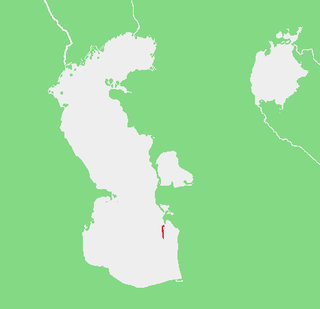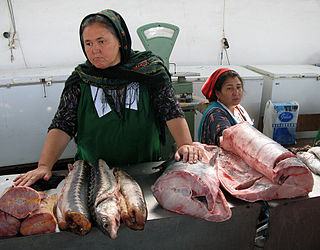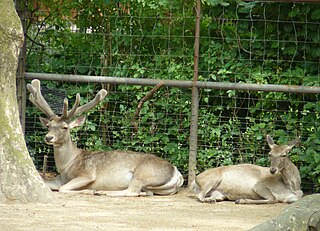Related Research Articles

Turkmenistan is a landlocked country in Central Asia, bordering the Caspian Sea to the west, Iran and Afghanistan to the south, Uzbekistan to the north-east, and Kazakhstan to the north-west. It is the southernmost republic of the Commonwealth of Independent States (CIS), the loose federation created at the end of 1991 by most of the Post-Soviet states.

Lebap Region is one of the regions of Turkmenistan. It is in the northeast of the country, bordering Afghanistan, Uzbekistan along the Amu Darya. Its capital is Türkmenabat. It has an area of 93,727 square kilometers, and a population of 1,334,500 people.

Türkmenabat, formerly and since medieval times Chardzhou, and in ancient times Āmul, is the second-largest city in Turkmenistan and the capital of Lebap Province. As of 2009, it had a population of approximately 254,000 people. From 1924 to 1927 it was briefly renamed Leninsk in honor of Vladimir Lenin.

Ogurja Ada is the largest island in both Turkmenistan and the Caspian Sea by area. Ogurja Island is also widely known by its Russian name Ogurchinskiy Island(Ostrov Ogurchinskiy).

Repetek Biosphere State Reserve, often referred to as Repetek Nature or Desert Reserve, is a desert nature reserve (zapovednik) of Turkmenistan, located in Lebap Province, East Karakum Desert, near Amu Darya. It is located approximately 70 km (43 mi) south from Türkmenabat and is known for its zemzen. Established in 1928 for the study and preservation of a sand-desert ecosystem, it covers an area of 346 km2 (134 sq mi).

Hazar Nature Reserve is a nature reserve (zapovednik) of Turkmenistan.

Köpetdag Nature Reserve is a nature reserve (zapovednik) of Turkmenistan.
Gaplaňgyr or Kaplankyr is a mountain plateau and nature reserve (zapovednik) of northern Turkmenistan. It was established in 1979.
Amyderýa Nature Reserve is a nature reserve (zapovednik) of north-eastern Turkmenistan.
Köýtendag Nature Reserve, formerly Kugitang Nature Reserve, is a nature reserve (zapovednik) in the extreme east of Turkmenistan.

Köýtendag District is a district of Lebap Province in Turkmenistan. The administrative center of the district is the city of Köýtendag.
Köýtendag is a city and the administrative center of Köýtendag District in Lebap Province, Turkmenistan. On 29 December 1999, by Parliamentary Resolution No. HM-61, the city and district of Çarşangy were renamed Köýtendag. On 27 July 2016, by Parliamentary Resolution No. 425-V the town of Köýtendag was upgraded in status to "city in a district".

The fishing industry in Turkmenistan has been of benefit to the economy of Turkmenistan and food supply, particularly on the Caspian Sea for centuries. The fishing industry took off around 1910 in Turkmenistan but declined between 1950 and 1990, with the banning of sturgeon catching in Turkmen waters. Today, the fishing industry is developing rapidly, due to technological modernization and renewal schemes and the growth of aquaculture. Under the command of the Turkmen president, fishing facilities in the country have been reconstructed and constructed with modern industry infrastructure, particularly in the Caspian Sea 610 km coastline of western Turkmenistan in Balkan Province.

The list of Turkmenistan-related articles is below
Amu Dar'ya is a town in Döwletli District, Lebap Province, Turkmenistan, on the river of the same name opposite the town of Kerki. As of 1989, it had a population of 5,018.
Sünt-Hasardag Nature Reserve is a nature reserve (zapovednik) of Turkmenistan.

The wildlife of Turkmenistan is the flora and fauna of Turkmenistan, and the natural habitats in which they live. Turkmenistan is a country in Central Asia to the east of the Caspian Sea. Two thirds of the country is hot dry plains and desert, and the rest is more mountainous. Very little rain falls in summer and the chief precipitation occurs in the southern part of the country in the winter and spring. The Caspian coast has milder winters.

The Central Asian southern desert ecoregion is an arid but ecologically active region between the east coast of the Caspian Sea and steppes at the base of the mountains of central Asia. Most of Turkmenistan and eastern Uzbekistan is in this ecoregion. The winters are milder than in the cold desert to the north, and a large number of endemic species have adapted to living in the particular climate and soil of the region. As with sandy deserts in general, the region is notable for high numbers of endemic species of reptiles and insects.

The Kopet Dag woodlands and forest steppe ecoregion coincides with the Kopet Dag mountains, straddling the southern border of Turkmenistan and the northeastern border of Iran. The region is one of high biodiversity, as it includes a full range of altitude zones, and variety of habitats included juniper-wooded slopes, montane grasslands, and tugay.
References
- ↑ "Nature Reserves of Turkmenistan :: About Turkmenistan Reserves". Oriental Express Central Asia. Retrieved 2014-02-13.